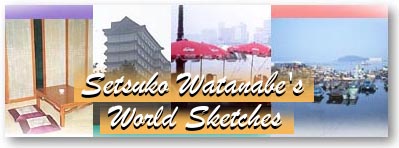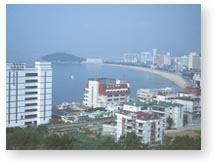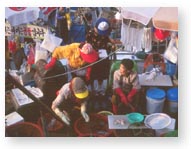 Moonlit Night on the White Beach of Haeundae Coast (The Republic of Korea) |

|
A rustic fishing port encircled by a small inlet.
The smell of the seashore. The deep-blue ocean. Street stalls lining the beach.
This kind of beach still remains, although in the midst of the city - an hour and half flight from Narita Airport and 20 minute drive from Korea's second biggest city, Pusan.
At first, you are overwhelmed by the high-rise buildings, like ones in Miami. But down at the far end of two kilometers of a white sand beach, you will find a small fishing port. From there, a five-minute walk up a steep slope between pumpkin fields will take you to a hill where people go for moon-viewing and to one of my favorite lodging houses. The rooms have heated floors, low dining tables and cupboards. If you watch Japanese TV via satellite, you might feel as if you're at a Japanese hot spring resort. But among my fellow guests, there are no other Japanese.
The view of the moonlit beach is beautiful.
In the south, there are many inlets encircling ocean waters. But this mysterious and enchanting night scene - created by the contrast between the chilly moonlight and the seductive stall lights - can only be found here. It is the harmony of the profound and the indecent, the moon and the living world. I was told that, in August, when the "mid-autumn full moon" appears, the area is crowded with tourists who've come to view the moon. I have heard that the Koreans admire the beauty of the pale moonlight even more than that of the brightly burning sun. Touch-me-not - a song written by Hon Ranba, whose sentiments of national independence are expressed through singing about a flower - can be heard softly in the distance, touching deeply into the hearts of the listeners.
I'm woken by the singing of birds from the veranda, but it is still dark outside. In the Hangul language, birds don't "chirp", "sing" or "twitter" but "weep" People, birds, winds and temple bells - all are said "to weep". For a race of people who have experienced so much sadness, the sounds of the world must all sound like weeping. When I took a walk down to the port, the morning market was in full swing. The moonlight had long faded and the sun was rising slowly and brightly in the sky. At the street stalls, sophisticated customers nibble at sashimi with their morning drinks, talking of the sunrise. They generously shared abalone and Korean rice wine with me. The vague sense of alienation and loneliness that I have felt traveling in Korea doesn't exist here. People living in harmony with the sea anywhere are full of liberating cheerfulness.
Links
Copyright1998 Setsuko Watanabe
|
- back to home -

